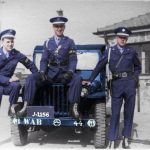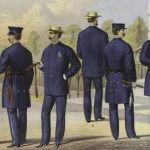Minimum Criteria to Qualify for Becoming a Cop

Law enforcement agencies are also concerned with the protection of certain public facilities and infrastructure; providing initial response to emergencies and other threats to public safety; the protection of public officers; the operation of some detention facilities, and the maintenance of public order.
There are certain minimum standard criteria required to be qualified for police training. In the United States, a typical criterion dictates that applicant must:
* Be a United States citizen
* Be in good mental, medical, and physical condition
* Clean criminal record
* Have a valid driver’s license
* Be of high moral character
* Not have a history of mental illness or domestic violence
Applicant needs to undergo repeated medical examinations, interviews, written tests, drug testing, and police oral board interviews to name a few. Recruiting is competitive and failure to meet some minimum criteria automatically disqualifies the candidate. Out of all the examinations, the most subjective one is the police oral board interview and often disqualifies the biggest portion of qualified candidates.
How Police Departments Had Their Beginning

Early American police departments were under the control of local politicians. The local political leaders, who were mostly the owners of neighborhood taverns or purveyors of gambling and prostitution, were the ones who appoint the police executive in charge of their local neighborhood. With the police being on these scrupulous merchants and political leaders’ payrolls, it’s no wonder that there was massive distrust with the police force.
With these known and rampant corruption and police brutality, in 1929, President Hoover appointed the Wickersham Commission to examine the perceived ineffectiveness of the police department to reduce crime rate. Despite the commission’s findings published in 1931 and 1932 that shocked the nation – with its report on police brutality, corruption, wiretapping, bribery, coercion of witnesses, and fabrication of evidence – the police department continued as a bureaucratic entity defiant to both outside influence and reform.
There were other attempts to reform the police department, oftentimes from the police commissioners and chiefs as well who were appointed as a replacement from the previous one terminated due to scandals. The goal of these reforms was to loosen the grip of politicians and corporations on the department.
By the 1960s, due to massive social and political changes happening in the country, they were many mass uproars on police brutality and oppression. It was now hard to ignore scandals created on how police handled large demonstrations and used its force to suppress the Civil rights movement.
In an attempt to improve the police image, the drive to professionalize the police and criminal justice system followed. In the 1970s and early 1980s, the police came again to a massive reorganization dubbed as “Taylorization of the police force”. Police departments reduced the number of their personnel. They also increased the division of labor within departments. Another change was breaking down the police tasks into more specific and specialized tasks. The “taylorization” aims to isolate the police from the neighborhood they were located and the social work aspect of policing discouraged. Instead of being too involved with the neighborhood, they wanted the police force to be efficient and focused on crime-fighting and crime-solving.
In the late 1980s, many police departments across the nation had started a new strategy to improve police image. Their strategy? Community policing. If earlier they were discouraging community involvement, with the new program, the police department wanted to have close relations with them. They aim to alleviate a wide variety of community problems, many of which were social in nature. The community policing program is an effort to decentralize the police, improve relations with the community, and to make citizens more comfortable with police presence.
Currently, there are 17,985 U.S. police agencies in the U.S. They include the City Police Departments, State Police or Highway Patrol, County Sheriff’s Offices, and Federal Law Enforcement Agencies. City Police also known as Municipal police can be a one-person agency (sometimes called town marshal) to a huge one like the New York Police department which employs 40,000 police officers. State Police or Highway Patrol provides statewide law enforcement duties such as investigations and state patrols. County Police have countywide jurisdiction and in case the place has both county police and county sheriff, county police duties are to patrol and investigate whereas county sheriff can serve papers and provide security to the courts. Federal Law Enforcement Agencies’ typical responsibilities include immigration and border management, countering fraud against the federation, national security, giving protection to the country’s head of state, or other designated important persons.
Post written by Lawrence Harrick. Lawrence can also be found writing for Credit Glory.
A History of Police in America

Before what we know now as the modern police, ancient policing differs between different civilizations. The ancient Chinese have “prefects” who did the policing for thousands of years. Under each prefect were subprefects who will be responsible for law enforcement in their area. The ancient Greeks used slaves to guard public meetings and do crowd control. During Roman times, it was the army, not the police, that provided the security.
The early modern policing was created in Paris, the largest city in Europe during that time. King Louis XIV created the office of ” lieutenant-general of police” who was the head of the new Paris police force. After the French revolution, in 1829, the first uniformed police in France was established known as city sergeants. The term “police” was originally a French word and was borrowed into the English language.
One might think that the United States police existed since the beginning of the nation’s civilization. However, it’s far from the case. In the United States, policing was earlier conducted by “watchers”. These are community volunteers whose primary duty was to warn others of impending dangers. The first known watch system was established in Boston in 1636, followed by New York in 1658, and Philadelphia in 1700. The biggest disadvantage of the watch system was its unsuccessful attempt to control the crime. Many of the watchers were not enthusiastic about being one. Some only signed up to evade military service, others are forced into service, or just performing the watch duties as a community punishment. Many of these watchers spent their time sleeping or drank on duty.
In the Southern states, the policing was done not to avoid crimes and maintain peace but rather to ensure that runaway Black slaves were chased, apprehended, and returned to their owners. The vigilante-style organization was called “slave patrol”. The use of slave patrol came to its end when the Civil War ended.
With urbanization happening quickly, was the modern organized police force established due to increased crimes, or was there another reason? The United States was not anymore a collection of small cities and rural towns. The population was growing and anecdotal reports suggest that urbanized cities experience more mob violence, prostitution, and violence against African Americans by white youths. Public disorder was more evident in urban centers rather than in rural towns. It emerged then that the main task of the police force during that time was not to combat crimes but instill public order.
In 1838, the first established American police force was created in Boston. Soon after, cities like New York, Chicago, Albany, New Orleans, and Philadelphia followed suit. In the 1880s, all major U.S. cities had set up their own municipal police force.
The modern police across these cities shared similar characteristics:
1. The police are not any more volunteers and are full-time employees
2. They are bureaucratic and publicly supported
3. Police follow rules and procedures
4. They are accountable to a central government authority
The main purpose of the police force during this time was not really to avoid or solve crimes. In the post-Civil War era, police tasks were more to break the strikes organized by labor unions. These strikes were considered as “riots” hence police intervention was requested by local economic elites. The use of the police force to break these strikes was considered cost-effective and politically useful. Today, this kind of police intervention will be considered anti-labor and won’t be tolerated but during those times, policing was pushed by local merchants and businesses to forcibly disperse demonstrating workers. Many businessmen were given keys to alarm boxes so they could call out police force at a moment’s notice.
By the end of the 19th century, the police department was highly connected to politicians and businesses, and police officers were regarded as corrupt and known to use brute force. The communities had a total distrust of the police department and they can’t be faulted because it was true. Merchants were known to support the development of bureaucratic policing institutions by ‘hiring’ the police force rather than someone from a private sector to protect their enterprises.
Police were also known to target “dangerous classes”. This underclass was easily identifiable because they were mostly poor, foreign immigrants, and Black people. Depending on what the “elite” required, the police will be there to do the tasks. For example, police might be called in to disperse labor-union protests or harass opponents of particular political parties. They can be paid to turn a blind eye to allow drinking, prostitution, and gambling.

 D5 Creation
D5 Creation